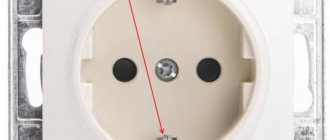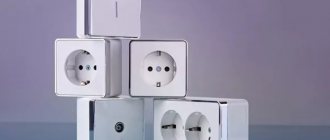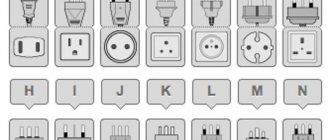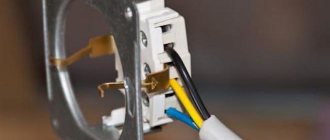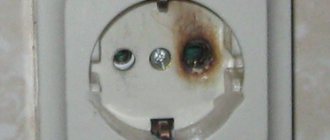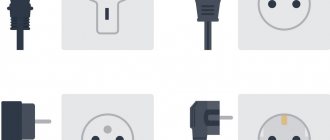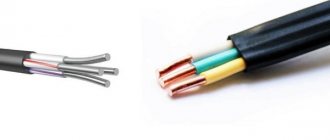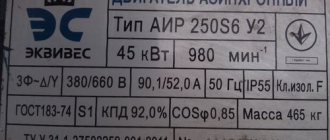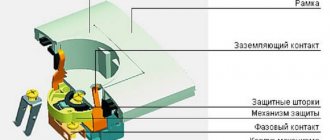Sockets are used to temporarily connect consumers to the electrical network. Their previous types were bipolar. Later, sockets with grounding appeared. At first these were three-phase sockets for 380, then they were followed by the so-called. European socket. Grounded outlets meet new electrical safety standards.
Structurally and in materials, sockets are in many ways similar to switches. The socket device includes a contact socket holder (base), the sockets themselves, their terminals for power wires and a housing. The base has mounting holes or push-down stops for hidden sockets.
Double pole sockets
These, with a round shape of plug contacts, are used in everyday life and offices for a voltage of 220 V in Europe and Russia. (In the USA and Japan 115 V with flat contacts). They can be with or without grounding. Grounded sockets are now replacing those still in use without grounding with a “thin” plug.
The Euro socket becomes the de facto standard and has thicker pins that are incompatible with older sockets. Previously, the only place for their attachment was walls, then, for the convenience of consumers, they began to be built into equipment and furniture. There are now different types on the market to suit all occasions.
Grounded outlets are also considered double-pole because the ground does not provide a path for operating current but serves only for protection purposes. They require a ground bus, although in many places they work without it. For example, in places where electrical network equipment has been preserved since the fifties of the last century.
Built-in sockets are used for convenience and space saving. For example, built-in sockets for the kitchen can be located in rotating and retractable housings built into the kitchen furniture. This makes it easier to work with electrical appliances, since the convenient location of the sockets significantly reduces the risk of the consumer getting caught on the cord and knocking something over or falling.
If they are not needed, they can be removed by pressing the housing or turning it. The sockets are hidden and the furniture looks more attractive. Pull-out sockets for countertops are usually designed as a triple socket - in the kitchen they often connect two appliances at the same time and a reserve would not hurt, so a triple socket is very optimal in this design.
In addition to such new products as retractable sockets for the kitchen, sockets with a timer are appearing on sale. Their purpose is to help save energy or create the impression that there are people in the house (to protect against burglars). Sockets with a timer are produced in several modifications. The simplest and most inexpensive models are combined with a mechanical countdown timer.
More advanced sockets with a timer, instead of mechanics, use a controller with a display and buttons for programming it. They allow you to create a schedule from many points or cycle a sequence of switching off and turning on. Naturally, they cost more.
All receptacles with a timer must provide at least 16 amps of current without overheating the contacts during continuous operation. The fact is that sockets with a timer are switched by electromagnetic relays; semiconductor switches do not provide electrical safety in terms of leakage currents (if the socket is disconnected, you can get an electrical injury).
Triple sockets in combination with a timer are rarely used, since each output must be controlled separately (except for very simple models with a mechanical timer), and this complicates the design. Manufacturers understand how easy it is to mislead consumers and do everything to eliminate any misunderstandings.
Child-resistant sockets are also available. Small children can become energized due to their curiosity, so on such products they use a mechanical blocking of access to its sockets, designed so that only adults or children of a sufficiently responsible age can overcome it.
Ceiling sockets are used to connect a chandelier; this is a completely separate type of socket. Also, stationary sockets built into the floor are not used - this is unacceptable in terms of electrical and fire safety and they will easily become littered with dust.
In addition to 220 V network sockets, sockets for other purposes appear in the same sizes, among which TV sockets for connecting televisions to antennas or cable networks have begun to occupy a prominent place. They are divided into two groups: there are end (terminal) sockets and pass-through sockets. The feed-through socket must provide a matched characteristic impedance for the subsequent pass-through or termination socket.
When planning the location of subscriber devices in rooms (TVs or computers), you need to take into account what is called the network topology. Usually for private consumers this is a very simple single-line chain of two or three through sockets and one terminal socket, sometimes there are branches. It is important to remember that a pass-through TV socket can be not only a pass-through, but also a tee, this helps optimize the length of the cables.
For outdoor use, outdoor sockets are used. Outdoor sockets are made in a protected design, from IP44 and higher. The double external street socket is the most common; hidden (mounted flush with the surface) street sockets are not used, they don’t even have a designation in GOST 21.614–88.
An outdoor outlet in this design is too vulnerable to moisture and unsafe. A double external socket often helps to get rid of unnecessary extension cords, which can be unsafe in wet soil and grass.
How to make the connection correctly
The question posed by the title of this section is quite serious. Especially when it comes to powerful household appliances. For example, a washing machine or an electric cooking oven. What should you pay attention to?
Socket design
The grounding socket (RP) of increased current rating has a letter designation of the zero contact - this is the Latin letter “N”. The grounding contact is indicated by a special sign - this is a vertical line, under it there are two horizontal ones: the top one is longer than the bottom one. The phase contact (connector) is not indicated by anything.
Attention! Color and contact marking is purely technically an optional measure. It was made for ease of installation. However, it is necessary to take into account that there are situations when it is necessary to adhere to these norms. For example, if the zero connector must accept large current loads, and accordingly it is larger in size.
Let's take a closer look at different types of grounded sockets. It should be noted that there are mainly three main designs on the Russian market. Their name corresponds to the countries of origin, where they are not only manufactured, but also mainly used.
- French socket with grounding. In it, the grounding contact is a pin that goes into the plug when plugged into an outlet. True, for such a connection you will have to look for a special plug with a hole for this pin.
- German. In this design, the grounding contacts are located on the sides and represent a kind of clamps. With their help, you can not only connect the ground loop, but also secure the plug in the socket.
- American. In this design, the ground contacts are located in the holes of the main connectors.
By the way, you can use various sockets for carrying, for example, a double external socket with grounding would be a good idea. This will increase the number of connected consumers.
Grounding circuits with protective functions, for example, with grounding circuits, are a modern requirement for electrical safety. With the advent of a large number of household appliances that are used by humanity every day, the likelihood of electric shock has also increased. And only the protective qualities of the network and the devices themselves help to avoid big troubles.
Expert opinion
It-Technology, Electrical power and electronics specialist
Ask questions to the “Specialist for modernization of energy generation systems”
Installation of open wiring Such mechanisms fail faster than classic models, so it is important to choose high-quality devices and check their performance. Ask, I'm in touch!
Three-pole sockets
380 volt sockets are made three-pole - one pole per phase. Almost all of these sockets are grounded; according to the new rules, this is mandatory. The 380 socket is made much more durable, using non-flammable materials.
A fire resulting from a short circuit in such an outlet is very impressive, since significantly greater power is transmitted in three-phase circuits than in single-phase circuits. Almost every three-phase outlet is external. All 380 V sockets are sealed with rubber bushings and gaskets to prevent moisture and dust from getting inside.
Designations of sockets for diagrams and drawings
To designate rosettes, a semicircle with an arc upward is used. The designation on the drawings differs from the image on the circuit diagrams. The figure shows several illustrative examples of notation.
Two-pole sockets are indicated by one stroke, three-pole sockets - by three strokes emanating from a common point and directed upward. There are no notations with two strokes from a common point. Two parallel strokes indicate a double two-pole socket (See GOST 21.614–88 for more complete information.).
A socket with a grounding contact is indicated by a horizontal stroke running tangentially. This is not a sign of a hidden installation, as some people think. A socket for installation in walls is indicated by a vertical line inside a semicircle. Symbols for sockets can be supplemented by symbols of switches (“poker”) - L-shaped strokes, if they are performed in conjunction with them.
All these designations have nothing to do with the connection, the latter are carried out according to the electrical circuit diagram, this is a completely different document. A wiring drawing is required only for installing sockets and switches, installing panels and laying wiring routes. The connection is made later to avoid confusion. You can read more about connecting sockets here.
Buy hidden wiring sockets in Ukraine. Price for built-in socket
Electrical appliances, equipment, household appliances, gadgets and devices surround us everywhere. If our parents had literally 4 sockets in their apartment when they were young, today 10 is not enough for us. As a result, we have to buy extension cords and tees, which makes the interior less attractive and practical . Progress does not stand still, so now you can solve the problem of the lack of sockets in the house by purchasing built-in models or a whole block of sockets. In the Electro Torg online store you can choose and buy high-quality sockets of any type at the most reasonable and affordable cost.
Types of sockets
There are two main types of fittings: built-in and overhead. Overhead devices are convenient because they are easy to install; you do not need to make a hole in the wall for a socket box. However, this installation option implies a strong protrusion of the outlet from the wall, which is not practical and sometimes dangerous (especially if there are children in the house).
Built-in devices are distinguished by the fact that their entire internal part, including the place where the wires are connected, is hidden in the wall. This device can be used for laying external and hidden wiring. You need to understand that you will have to tinker with the installation of a hidden socket box. There is a category related to the built-in type - retractable sockets; their price is slightly higher than conventional devices, but they are convenient to use.
It should be noted that for those who need a large number of sockets, series blocks are perfect. They are most often used in shopping centers, offices, and warehouses, but they are also installed at home. Socket modules are built into tables and upholstered furniture. Hatches for modules are available in horizontal and vertical assembly; the assembled design can accommodate almost any number of sockets and connectors. The vertical version allows you to fit more sockets, as it can be placed on all four sides.
The choice of mortise units also depends on the type of power supply and voltage: 220V – for home use in apartments or houses, 380V – for production rooms, as well as for connecting machines and machines.
How to choose an embedded option
When choosing a suitable built-in socket for an apartment or house, you need to consider the following nuances:
- Suitable design and appearance.
- Product safety, level of protection.
- Reliability and durability.
Design
If we talk about the external design of mortise units, then the choice is huge. In our online store you can choose all the fittings for your room in the same style or color. Both standard frames and unusual ones are available. White shades look harmonious in almost any interior. However, you can also choose other colors, for example, black or blue rosettes, silver fittings, walnut or ivory products.
Safety
Safety is something that guarantees not only the reliability of the wiring, but also the safety of human life and health, because devices of poor quality can cause a short circuit or fire.
- IP20 – built-in devices that are installed in dry rooms (suitable for bedrooms, corridors, living room).
- IP44 – built-in units for rooms with high humidity (will fit perfectly into a bathroom or kitchen)
- IP54 – can be safely installed outdoors and in rooms with high humidity levels.
Grounding is also responsible for safety. There are built-in, surface-mounted options with and without grounding. At its core, a grounding device is a regular model that has one additional wire. This design allows for safety in the event of damage to the mechanism, because its body is grounded even before voltage is directed into it. In our store you can buy such installations cheaply.
Durability
The service life of the device depends on the quality of the assembly and plastic, the material of the wires, the degree of safety and protection. As a rule, all this is available in built-in models from successful and reliable manufacturers. In our online store you can purchase high-quality products from brands such as VIKO, ELBI, LUXEL, LEGRAND, etc.
We offer our customers favorable terms of cooperation. The range of products is large - you can inexpensively buy mortise, built-in overhead models, blocks of retractable units, additional parts for electrical wiring, switches (for example, 16a, 14a). Product prices are quite affordable - starting from approximately 25 UAH. Customers have the opportunity to take advantage of fast delivery of goods to Kyiv, Kharkov and other cities of Ukraine.
Source: https://electrotorg.biz.ua/category/elektrofurnitura-klass-elektrofurnituryi-rozetka-tip-ustanovki-vreznaya-skryitaya-provodka
What is a household plug socket?
November 14, 2013
A plug socket is one of the components of the electrical network, without which the task of connecting devices becomes significantly more complicated. Despite the large number of existing models (waterproof, dual, grounded), the basic principle remains unchanged. Indeed, a plug socket makes it possible, at minimal cost, to provide a safe connection to the network of electrical appliances for anyone, even without a security clearance.
Although the plug socket is a structurally complete device, it cannot be fully operated without a plug, with which it creates a detachable connection using copper sliding contacts. In other words, the consistency of the solutions used is important. For example, a plug socket with two sockets (holes) is designed for a corresponding plug with the same number of pins (pins), and the diameter should not exceed the permissible value.
Let's consider what features are inherent in sockets used in household electrical networks. One of the key differences is the case material (not to be confused with the outer cover). The socket can be made of ceramic or flame retardant plastic. The latter, despite its high performance characteristics, is inferior in terms of resistance to heat (it deforms at high temperatures, caused, for example, by poor contact crimping) and permissible breakdown voltage (the best insulators are glass and ceramics, not polymers).
Now that outdated home wiring is being replaced everywhere, a plug socket with a grounding contact is becoming indispensable. If in Soviet times a two-wire network (zero and phase) was considered the standard, now, in accordance with the requirements of the PUE, a grounding loop is installed and a third grounding wire is additionally installed. This significantly improves electrical safety. It connects to a special contact in sockets. Equipment that requires the use of grounding is sold with special plugs in which the housing is connected to the third contact. When you turn on the plug, not two wires come into contact, as before, but three wires. Such sockets can be of two modifications: when the plug has three pins that fit into the holes as standard, and also (a more convenient solution) when there is a spring-loaded sliding contact, which additionally secures the plug when it is turned on. The peculiarity of the latter is that when turned on, a grounding circuit is first created, and then deep power conductors are created. In retail chains you can find sockets of a special design, in which the holes are closed with plastic curtains, which need to be moved with pins to insert the plug.
Installation of plug sockets
There are models for external (open) and internal installation. Sockets of the first type are used, as a rule, in conjunction with external wiring, in which the wires are not hidden in the wall, but are fixed to small insulators or placed in cable ducts. Usually these are industrial premises, barns, street chains. If the lower part of the socket is not equipped with a closing cover, then you need to attach a plate of non-conductive material (textolite, wood) to the base. Then disassemble the socket body and use screws or bolts to place it on the prepared area. Wiring can be connected both before and after installation on the base (necessarily in a de-energized state of the network).
Models for hidden installation are equipped with internal metal “paws”, which, when tightening two screws, move apart, securely fixing the entire structure inside the mounting box. Installation is simple: a hole is prepared in the wall, the diameter and depth of which correspond to the selected plastic installation box; then a channel is made for the wire from the main line; the ends of the wires are connected to the socket terminals intended for this purpose; fixation is in progress; the outer cover is installed.
Incredible Transformations: 16 Prisons That Have Been Converted into Luxury Hotels If you're looking for an unforgettable experience on your trip, consider choosing a unique hotel, such as one that used to be a prison.
How to look younger: the best haircuts for those over 30, 40, 50, 60 Girls in their 20s don’t worry about the shape and length of their hair. It seems that youth is created for experiments with appearance and daring curls. However, already last.
Contrary to all stereotypes: a girl with a rare genetic disorder conquers the fashion world. This girl's name is Melanie Gaydos, and she burst into the fashion world quickly, shocking, inspiring and destroying stupid stereotypes.
7 Body Parts You Shouldn't Touch with Your Hands Think of your body as a temple: you can use it, but there are some sacred places that you shouldn't touch with your hands. Research showing.
13 signs that you have the best husband Husbands are truly great people. What a pity that good spouses don't grow on trees. If your significant other does these 13 things, then you can s.
9 Famous Women Who Have Fallen in Love with Women Showing interest in people other than the opposite sex is not unusual. You are unlikely to be able to surprise or shock anyone if you admit it.
Open wiring socket, two-socket with grounding
» Articles » Two-socket open wiring socket with grounding
Quick view
Delivery: Perm
TO THE STORE Online consultant Toll-free number 8 800… Quick view
Delivery: Perm
TO THE STORE Online consultant Toll-free number 8 800…
2 page of 53
perm.regmarkets.ru
Open wiring socket, double, 10 A
| Series: | Switches, sockets |
The open-mounted socket is mounted on the wall on top of the decorative trim. The advantages of the model compared to closed-type products are: ease of installation, quick access to wires, convenient repair or replacement.
The double socket is made of durable ABS plastic, supports a rated current of 10 A. Technical characteristics: Rated current: 10 A. Voltage: 220 V. Differential current protection: no. Version: without protective contact.
Number of nests: 2... more ». Childproof: no. Connection method: screw terminal. Degree of protection: IP20. Material: ABS plastic. White color.
Dimensions: 10.4x6.2x3 cm.
« hide
53 rub. in stock* planned delivery date: 05/04/2019 (Sat.)| package | plastic bag |
| packing size | 104x65x30 mm |
| country of manufacture | Russia |
| material | plastic |
| color | white |
| 89-0-402 | |
| weight | 100 g |
| discount system code | 25 |
| code in My-shop.ru | 2586549 |
With this product they buy...
my-shop.ru
Instructions on how to connect a grounded outlet
At the moment, people cannot imagine their lives without comfort. One of its components is electricity. Most of the appliances in the house operate from the electrical network, moreover, it should be noted that current, as a phenomenon, is incredibly dangerous for humans. It is for this reason that different degrees of protection are used. A grounded socket has become one of the elements that ensures the safe operation of a household network.
The photo shows the process of connecting the socket
Why is grounding needed?
Many people wonder why exactly a grounded outlet is needed? The answer to this question goes into the school physics course. The reason for the need to create grounding is human safety. The difference between an outlet with and without grounding is an increased level of safety. the likelihood that a person will get an electric shock when using a grounded outlet is reduced several times. Read what a switching power supply is.
Specifications
Grounded sockets have the following technical characteristics:
- Product type;
- Number of keys;
- Case color;
- Type of installation of the structure;
- Series;
- The presence of a cover or curtains.
The socket with grounding is shown in the photo
Today on the domestic market of specialized electrical equipment you can purchase the following types of electrical sockets:
- double internal socket with grounding - this type of equipment meets high technical specifications, is safe and is as practical as possible, because it has several input holes for connecting electrical appliances to the network.
- surface-mounted with grounding - this version of sockets is the most common among the Russian population. The reason for this is ease of installation.
- two-socket open wiring - in this case, to install the structure you will need to have at least a little knowledge in the field of wiring and working with electricity in general. The picture shows a two-socket open wiring socket with grounding
- external with IP54 cover – this version of sockets is highly reliable. Suitable for rooms with high humidity and apartments where there are small children. The picture shows an external socket with a cover IP54 with grounding
- hidden wiring - in this case, installation should be performed by experienced specialists. Sockets of this type are practical to use and durable.
- Legrand Valena is a manufacturer with high quality standards. is one of the three leaders in the domestic market of special equipment. See an overview of the types of LED phytolamps for plant seedlings here: https://howelektrik.com/osveshhenie/lampy/svetodiodnye-fitolampy-dlya-rassady-rastenij-obzor-vidov-i-kak-vybrat.html. Legrand Valena socket with grounding in the photo
- Etika white - meets European quality standards, has a simple design. The photo shows a white grounded socket Legrand Etika
- grounded socket with curtains - products of this type can be used in unheated rooms and where the likelihood of sudden temperature changes remains high. The picture shows a grounded socket with curtains
The picture shows a double internal socket with grounding
Installation and connection
Watch the video clip, which tells about the correct connection of the block with sockets:
When installing and connecting the socket, you must perform the following steps (this applies to all types of sockets (single, double and triple), the only correction will be for the phase wires:
The photo shows the process of attaching wires to the socket
- Before connecting, you need to check the wires and, if necessary, wire them.
- Before performing this, de-energize the output.
- Identify phase wires, grounding and neutral wires.
- To check the wires, you can use a special indicator probe.
- When connecting, it is recommended to connect the phase to the right terminals, zero to the left, and as for grounding, it is attached either to the central or to the bottom terminal.
The picture shows schematically how to attach the wires
Fastening the wires is shown in the photo
The picture shows the installation diagram of a double socket
For clarity of the whole process, it is worth familiarizing yourself with the video material presented below.
How to check if there is grounding?
To check the presence of grounding in an outlet, you must use special equipment and follow a certain sequence:
- You can use either a multimeter or an indicator screwdriver, the essence of the process will remain the same.
- To check the presence of electricity in the network, plug in a table lamp into the outlet. If it lights up, it means there is electricity. Read what corrugation for cables and wires is and how to choose on this page.
- When turning it on, you should not touch the ground, because it is not yet known whether the outlet is grounded or not.
- Unplug the outlet.
- Unplug the lamp and remove the socket.
- If the grounding contact approaches one of the terminals, then this is grounding. If a separate wiring is used for connection, then this is grounding.
- Return the socket to its original state and turn on the machine.
- Using a multimeter, check if there is a grounding phase contact. If the device shows its presence, then you need to contact a specialist.
The video below will help you check the grounding:
The photo shows the process of checking for grounding
Cost of overhead socket with grounding
At the moment, you can purchase a grounded socket in any specialized department or retail outlet that sells equipment for laying the electrical wiring system and its complete installation.
It is worth noting that, based on the average statistical indicators for Russia, the cost of a double socket, external with grounding, will vary from 120 to 300 rubles.
As for hidden wiring with grounding, its price will need to be clarified with the company that will install this very system. According to preliminary estimates, the price for this type of work will vary from 5,000 to 8,000 rubles.
Where to buy a grounded socket?
Where to buy in Moscow:
- LLC 220PRO Moscow, Marshal Zhukov Avenue, 74, building 3 Contact phone number, +7 (495) 540-49-82;
- Trading company Leroy Merlin Moscow, st. Shabolovka, 31A Contact phone
- Trading company Izolux. ru Moscow, st. Molodogvardeyskaya, 61 Contact phone:8
Where to buy in St. Petersburg:
- LLC "TD "TehPromSnab" St. Petersburg, st. Trefoleva, 2 Lit AYu Contact phone, +7 (812) 747-31-92;
- MIRA Company St. Petersburg, Yuzhnoe Highway 37 Contact phone number;
- LLC KEP-Engineering St. Petersburg, Moskovskoe highway, 46, lit. Ah, pom. 221v Contact phone number.
Watch the video for instructions on connecting the socket:
Attention, checking the grounding and directly installing the socket can be performed independently only if you have experience in performing such work. If there is none, then you need to use the services of an experienced master. Otherwise, the consequences can be very sad. Read about how to connect a light bulb through a switch on this page.
Dec 1, 2015 Tatyana Sumo
howelektrik.com
Source: https://stolyarka-mos.ru/stati/rozetka-otkrytoj-provodki-dvuhgnezdnaya-s-zazemleniem.html
Overview of recessed and non-recessed type sockets
Scientific and technological progress allows us to gain access to new gadgets every day that make our lives easier. Most of them require an electrical connection to operate, which is provided by a plug socket. This is a switching node - a point that organizes the connection of a common and separate, independent circuit (electrical circuit of the gadget).
In fact, this term hides an ordinary household socket, but the scope of its application, the conceptual and practical decisions of manufacturers, and operating conditions influence the characteristics of the equipment.
- What is the socket for?
- Socket device
- Types of plug sockets Design differences
- Electrical diagram
- Protection level
- Number of working pads
- Performance indicators
What is the socket for?
Imagine a situation where you need to get inside a house in order to be able to use the benefits hidden there. To do this, first of all you need to find the front door, then use it for its intended purpose. If we draw some parallels and analogies, then any portable or stationary device or equipment must look for a connection point to the electrical network in order to be able to realize its purpose. Such a point, the input, is a two-pole plug socket.
Taking into account the general high dynamics of social life, the specifics of switching on electrical equipment, the socket, its dimensions and structural elements should provide the owner with the ability to quickly and reliably switch the circuit - close or open contacts. This effect is achieved due to the special layout of the connection, which is a combination of plug (plug) and socket (actually, socket).
Socket device
Any socket consists of three main parts:
- Protective and decorative body;
- Mounting block;
- Contact block.
The body consists of a front decorative frame (lid) and a socket box. The frame hides the connection block from the outside, forming a socket for the plug. The socket box limits the block with contacts from the back and sides, forming a kind of pocket. It can be part of the socket if it is a non-recessed type (surface) with open wiring, or mounted separately in a wall hole if the socket is built-in (recessed).
The block is a ceramic block containing contacts and fasteners for installation in a socket box and fastening the cover.
Contacts are either key or screw type. They differ in size and configuration. They have a two-way connection: the phase, neutral, and grounding (if any) wires from the network are connected on the inside, and the contact legs of the plug are connected on the front side. Contact elements are made of elastic metals.
Types of plug sockets
There are plenty of criteria for evaluation. The main ones can be considered design (dimensions for mounting elements), electrical circuit, level of protection, number of working blocks, technical characteristics, etc.
Our readers recommend!
To save on electricity bills, our readers recommend the Electricity Saving Box. Monthly payments will be 30-50% less than they were before using the saver. It removes the reactive component from the network, resulting in a reduction in load and, as a consequence, current consumption. Electrical appliances consume less electricity and costs are reduced.
Design differences
In terms of design, or, more precisely, installation diagram, the plug socket can be recessed or external. In the first case, the socket box is missing as a component - it is a plastic cup for mounting the block elements, built into the prepared hole.
This is the most commonly used design because it has an obvious decorative effect: when the wiring is hidden, a thin frame can be seen from the outside. Surface-mounted sockets, on the contrary, have a composite socket box that is mounted on the wall. In this case, an open network is used. Its visual differences can be seen in the illustration below (upper left corner and right side).
Electrical diagram
According to the organization of electrical connection, the plug socket can be two-pole or three-pole (with a grounding contact). In everyday practice, both are used - it all depends on the presence of organized grounding or its absence. Visually they differ from each other by the metal brackets protruding into the plug socket.
Protection level
Connection points can be located in places with different moisture concentration conditions. This forces us to take some constructive measures to protect contacts. In practice, semi-hermetic and hermetic plug sockets are used, which have different levels of connection protection, and therefore different areas of application. There are different solutions, from the use of a protective shutter mechanism for openings to closing covers (in the illustration above).
Number of working pads
With the ever-growing number of household appliances dependent on electricity, the question of the number of connection points arises. A striking example of this is the kitchen. But sticking a sufficient number of sockets around the perimeter is not an option, since this is an expensive, labor-intensive process, with an extremely unaesthetic result. It’s another matter if you place several group points that combine from two to four or more outlets. In this case, the front part can be either single or modular.
Performance indicators
Each socket has its own technical characteristics, which limit its scope of application. These include:
- Degree of protection (moisture-proof, ordinary sockets);
- Rated current (is at the level of 10-16 A);
- Rated voltage (sockets are divided into two-phase, three-phase, etc.);
- Installation dimensions.
Features of installing a socket with two sockets
Before connecting the device, you need to determine where the phase and zero are located. The easiest way is to study the markings of the wires: phase - brown, black, white or red, zero - blue, white-blue, ground wire - yellow-green.
If you don’t trust the markings, you can independently check the location of the phase and zero. You can do it like this:
- Wear rubber gloves.
- Apply a special tester screwdriver to each wire.
- Evaluate the signal from the screwdriver - the light will light up in phase.
Before installing a double socket, you need to de-energize the wiring - turn the switch on the machines or one (necessary) machine to the “off” position. Next, in the place where the product will need to be placed, the voltage is re-checked using a special screwdriver.
There are some features of installing a double socket as opposed to a single socket. The double socket has one socket box (cup) with two separated terminals, 1 mounting compartment for wires.
The installation diagram is as follows: a grounding cable should be connected to the central or upper terminal, with the phase on the right and zero (neutral) on the left.
You only need to choose a cable from the same material and with the same cross-section as the main wiring. If you plan to install 2 socket boxes, you will have to drill holes in the wall for them with a drill, maintaining the required distance for the holes. Before installation, markings should be applied to the walls if the old outlet was not there.
Installation of individual electrical points
After selecting specific products and laying the wiring, installation of plug sockets is carried out. It all depends on which design scheme is chosen.
For a recessed two-pole socket with or without a grounding contact, a hole is first made in the wall at the location where the socket box is installed. The choice of tool (hammers, grinders, core drills, etc.) depends on the surface material. At the connection stage (after installing the glass), the terminal block with fasteners is separated from the decorative frame, the elements are installed and secured in the socket box. After this, the front panel is screwed on and the installation can be considered complete.
Surface-mounted sockets for an open network are also disassembled before installation, but unlike a recessed one, there is no need to groove the walls. The socket box with the terminal block is screwed with dowels to the surface. After this, the wires are connected and the cover is installed.
A plug socket is one of those elements that surround a person in his everyday and professional activities. However, their choice should be treated quite scrupulously, because the safe operation of all electrical appliances and the network itself depends on it.
Types of double sockets
An electrical outlet is a device necessary for connecting electrical appliances to the network. The product consists of a body (cover), which isolates the working part from external influences, and a main part with a base and contacts.
Sockets can be not only single, but also double, and even multi-socket, depending on the number of plug connectors. It is a mistake to think that doubling single sockets means getting a double one; in fact, only a monolithic device is considered two-socket.
The disadvantage of double products is the division of electric power into two parts, which should be taken into account when connecting two electrical appliances at the same time.
There are different types of double sockets according to modifications:
- Closed. The openings of the device are covered with special curtains, which is convenient for apartments where small children live.
- Open. Externally, they look like familiar sockets without closing curtains.
Devices can be with or without grounding. If grounding contacts are provided, this will protect connected devices from voltage failures. There are separate types of sockets for installation outdoors and in rooms with high humidity - waterproof. The former are protected from dirt and dust, the latter are protected from water penetration.
Double products are:
- invoices (external);
- hidden (internal);
- standard;
- polar;
- programmed, etc.
Plug sockets differ in the number of contacts
- Two-pin;
- Three-pin. a) with flat contacts - two power and one ground; b) combined - with two cylindrical power contacts and one flat grounding contact;
- Four-pin – with flat contacts (3 power and 1 ground).
Currently, grounding contacts are installed on modern domestic models and on all foreign sockets. As I already wrote, a grounding contact removes static electricity and is necessary for long-term safe operation of electrical appliances (electric kettles, electric water heaters, air conditioners, computers, TVs). The old Soviet-style wiring does not have a grounding contact.
Features of the plug socket
I would like to note that there are some differences between sockets and plugs of domestic and foreign production.
The socket of a European-made plug socket has a larger diameter than the sockets of domestic sockets. The distance between the pins of European forks is greater than that of domestic ones. A European-made plug socket is designed for a current of 10 or 16 A, while our Russian sockets are designed for a current of 6.3 or 10 A. The diameter of the pin for a domestic plug is 4 mm, while for a European one it is 4.8 mm
When choosing a plug socket, you should consider the number of devices that can be connected to it. Nowadays, there is a huge selection of plug sockets from domestic and foreign manufacturers, varied in quality, price and design.
Well, that’s basically all I wanted to tell you about the plug socket. Bye everyone. See you again on the pages of the site. For further information, see the site map.
Sources:
The modern electrical accessories market offers a large selection of sockets, each of which has its own area of application and operating features. Prostocomfort will help you understand the types and types.
Sockets are devices through which household appliances, devices and computers are connected to an electrical, television, telephone, radio or computer wired network. Accordingly, the sockets are:
- electrical;
- television;
- telephone;
- radio;
- computer.
All sockets are designed so that you can only plug in your own device. For example, it is impossible to connect a television connecting cord to an electrical outlet, and a power plug cannot be connected to a television outlet.
Electrical outlets are sometimes called power outlets, and television, telephone, radio and computer outlets are sometimes called telecommunications outlets.
Block of electrical, telephone and television sockets
(Source: PRODAX product catalog).
Types of sockets
There are two types of sockets: for hidden wiring and overhead. Sockets for hidden wiring are “recessed” into the walls. From the outside, only a decorative panel with sockets for the pins of the power plug (TV plug, computer connector, etc.) and a frame are visible. Surface-mounted sockets are used with exposed wiring. They have their own housing and are installed on the surface of the walls. Sockets for hidden wiring look more aesthetically pleasing and take up less space.
A block of an electrical outlet and a switch for hidden wiring with a common double frame.
(Source: ABB Product Catalogue).
Socket arrangement
All household sockets for hidden wiring consist of three main parts: a mechanism, a decorative panel and a frame. The overhead rosette consists of a mechanism, a body and a decorative panel. Sometimes in these sockets the body and panel are one piece.
The mechanisms of all sockets contain terminals for connecting wires and contact sockets for inserting network plugs, plugs or connectors. In addition to its decorative function, the decorative panel protects a person from touching live parts.
Electrical socket for hidden wiring and switch installed separately.
(Source: PRODAX product catalog).
More complex socket mechanisms may contain:
- automation elements: timers to limit the operating time of an electrical appliance plugged into an outlet, a thermal relay to protect against overheating of the outlet, microprocessors of a distributed control network of a smart home system, etc.;
- protective equipment: fuses and circuit breakers in case of short circuits, differential relays for protection against current leakage and human contact with live parts, overvoltage protection devices for electrical appliances; arresters to protect electrical appliances when struck by lightning;
- additional mechanical devices, for example, ejectors (catapults) of power plugs, which allow you to remove the plug from the socket by simply pressing a button;
- miniature light indicators of the presence of electricity in the network.
There are sockets with devices to protect children from electricity, that is, with curtains or covers.
Disassembled two-pole electrical socket for hidden wiring.
(Photo by the author).
Electrical sockets
Electrical sockets are used to connect electrical appliances and machines to the electrical network. Electrical sockets are:
- bipolar (without grounding) for a current of 10 A;
- three-pole (with grounding) for a current of 16 A;
- three-pole (with grounding) for electric stoves with a current above 20 A;
- three-pole (with grounding) for a current of 16 A with a protective cover;
- three-pole sockets for a current of 16 A with an increased degree of protection from moisture and dust for installation on walls outside the house.
Surface-mounted electrical socket with increased protection from dust and water.
(Source: electrical sockets, except for sockets for electric stoves, allow the inclusion of a standard two-pole or three-pole (with grounding) power plug. Only a three-pole plug-connector of the appropriate design is suitable for the socket for electric stoves. Therefore, such sockets are sold complete with “their” connector.
All modern electrical outlets for hidden wiring have a modular design and allow block installation. That is, they can be installed in blocks of two to six pieces in a row under one block frame. The sockets of such a block can include not only electrical ones, but also telecommunication ones.
Mechanisms and decorative panels of sockets for hidden wiring: three-pole (with grounding), three-pole with a cover, two-pole (looked from top to bottom).
(Source: PRODAX product catalog).
Telephone sockets
Telephone sockets are used to connect telephone sets to a wired telephone network. The telephone socket mechanism differs from the electrical socket mechanism only in the contact socket and allows block installation with modular sockets of other types. Telephone sockets use one or two RJ 11/12 contact sockets, to which one or two telephone sets can be connected.
TV socket for hidden wiring with connected TV cable.
(Source: ABB Product Catalogue).
Computer sockets
Computer sockets are used to connect computers and other IT devices (modems, routers) to wired information networks. Computer sockets use RJ 45 contact sockets. These sockets can also be used in the same block with other types of modular sockets.
Mechanisms with decorative panels for computer sockets for hidden wiring.
(Source: PRODAX product catalog).
TV (radio) sockets
Television sockets are used to connect televisions to the cable television network and radios. Such sockets can have one, two or three contact sockets of a special design. If the socket has two contact sockets, then, depending on the design of its mechanism, a TV is always connected to one of the sockets for watching cable television programs. The second can be used to connect a TV to a satellite dish or to connect a radio. To avoid mistakes, the corresponding designations are printed on the decorative panel of the socket. If the socket has three contact sockets, then through it you can connect to all three sources of television and radio signals.
All TV sockets for hidden wiring are modular and can be used in blocks.
Mechanism with a decorative panel for TV and radio sockets for hidden wiring.
(Source: PRODAX product catalog).
Series of electrical installation products
Most manufacturing plants of electrical installation products or electrical accessories (a name invented by designers) produce them in series. Series produced by the same plant often differ from each other only in decorative elements, that is, the panel and frame. And the mechanisms of products in different series are the same. This makes it possible to increase the variety and color range of products at minimal cost. As a rule, electrical accessories of one series are purchased for one house, which significantly improves its interior. When changing interior elements, for example, wallpaper, it is enough to select and replace only decorative elements of electrical accessories without dismantling the mechanisms of these electrical installation products.
Multiple block frames
(Source: Vi-Ko Product Catalog).
Electrical accessories of one series
KOPP
Product Catalog ).
Internal socket for hidden installation
A distinctive feature of the modern market for the proposed fittings is the variety of devices used during installation. One such product is an internal socket.
- 1 Design and application
- 2 Types of socket devices
Device and application
A hidden wiring socket is used to power various electrical appliances that may abound in a modern building, be it an office, a private apartment or a building as a whole. Its main elements are:
The presence of a contact group ensures the connection of devices through an outlet to the power supply network. The contact is made of a special alloy, which has good elasticity and electrical conductivity. Elasticity allows you to firmly hold the connection of the device. Modern devices can withstand currents up to 16 Amps. There are more, but this already applies to custom and special types of socket devices.
Here it is worth noting that the old-style hidden installation socket for the most part does not correspond to the contact part of most modern electrical appliances, and therefore you must either replace it or purchase a special adapter for the Euro plug. For correct operation of the equipment, the presence of another conductor is also required.
This grounding conductor is made based on special requirements in modern electrification of premises.
In other words, this is the basis. Performs the function of fastening the housing and contacts. Material – ceramics, carbolite, plastic. The block has excellent dielectric properties. However, at the same time, it is quite fragile and brittle, which means it is not worth testing its strength.
Protection of internal parts and wires. On the body there are holes for connecting the mating part of electrical appliances.
Types of socket devices
Hidden wiring sockets can be divided into the following main types:
- Overlays that are installed on top of the wall. The use of this type of device is carried out in the presence of wiring, which is laid in both hidden and open ways. There is no need to drill a special hole in the wall.
- The socket is internal; during installation it is necessary to prepare the seat. It is used only for hidden wiring, in which all parts of the socket and the contact group and block are placed in a pre-made hole, while the housing remains at wall level. Installation is carried out in a special box called a socket box. The pads have special fastenings to facilitate installation.
If you have main types of sockets, you can consider devices with additional functional or design features:
- Hidden socket with grounding. Sockets, which include not only mounting points for phase and neutral connections, but also a special contact called grounding. A conductor is connected to it, which performs protective functions. The use of this kind of sockets is found in modern design, where the presence of such a conductor is mandatory.
- Double (two-socket) or triple. It is possible to connect more than one electrical appliance to these types of outlets at the same time. It has one block of standard dimensions. The block should be installed in a regular single socket box. When installing more of these hidden devices, the installation of additional socket boxes is already required. For visual effect, they can be combined with one decorative frame.
- Sockets that have additional functions. These types of functions include the presence of:
- curtains, the role of which is to protect children from the possibility of electric shock;
- light indication for orientation;
- covers to protect contacts from moisture;
- ejectors.
- Pass-through socket devices. It is used when there is installation without using boxes. The power wire goes through the outlet in transit to the next one.
- Various special sockets. Their essence is the same as regular ones, only they provide other functions, for example:
- telephone, to ensure communication between intercoms;
- antennas, for transmitting video signals from transmitting stations;
- computer ones, outwardly similar to antennas, but they are used to connect computer devices into a single network space.
- combined sockets
